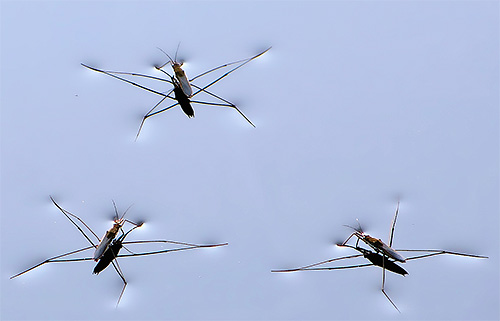
Almost always, while resting near the water, one has to observe a small insect with exorbitantly long legs, which very quickly and deftly glides over the surface of the water. This is a water strider bug: its very name speaks of the main difference between this species and other similar insects.
The bug with extraordinary dexterity is controlled with its paws and moves through the water like a skater on ice. It used to be said that the bug “measures the water”, which is why the well-known name stuck to it.
What does a water strider bug look like
There are a great many species of water striders - about 700. They all differ from each other in appearance, color and lifestyle.


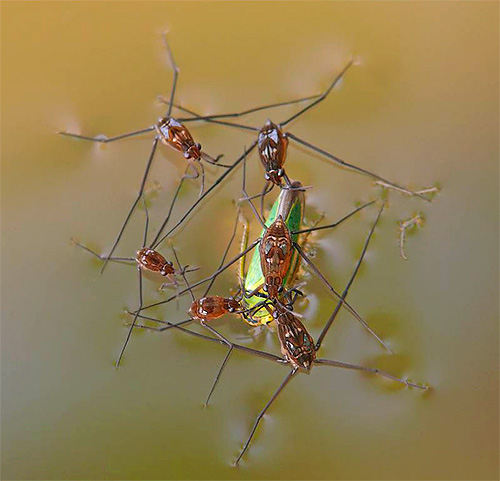
The narrow elongated body of the water strider bug (its size can vary from 1 mm to 3 cm) looks like a small stick equipped with 3 pairs of legs of various lengths. The front legs are much shorter than the rest, they are used to capture prey and regulate the speed of movement on the water.
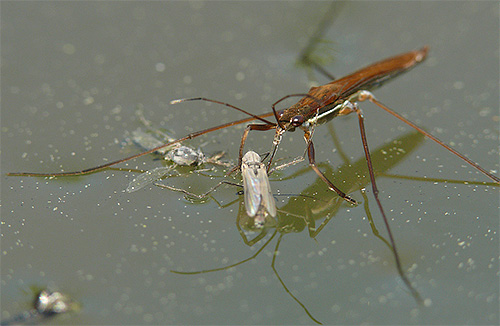
The middle and hind legs are one and a half to two times the length of the body of the bug itself and are used as a reliable support and turning mechanism, as well as for jumping.
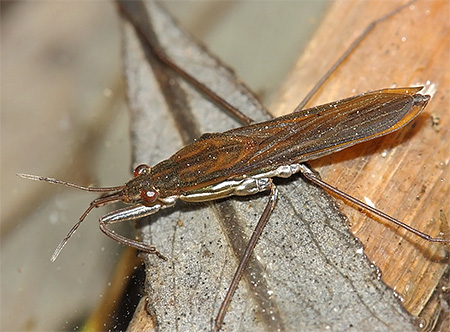
The bug is held on the water due to the surface tension of the latter, which creates a kind of film. The bug on its paws, like a man on skis, glides over the surface, never falling under water.
On the head of the water strider there are sensitive antennae that help the insect to pick up sound vibrations from the surface of the water. The antennae also act as an organ of smell and touch.
The mouth apparatus is represented by a jointed piercing-sucking proboscis, used by the bug to suck out the contents of the body of its victim.
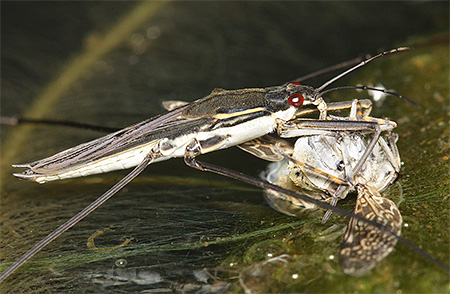
Some water striders have wings that make it possible to travel long distances in search of new water bodies, to temporarily populate puddles. However, bedbugs do not like to fly very much and try to do it in exceptional cases. Wingless bugs live in the same pond all their lives.
The body color of different species of water striders can vary from light gray and greenish to dark brown. A speckled pattern is usually located on the lower surface of the back. No very noticeable or bright drawings can be found on it. How exactly an adult water strider bug looks like can be seen in the photo below:
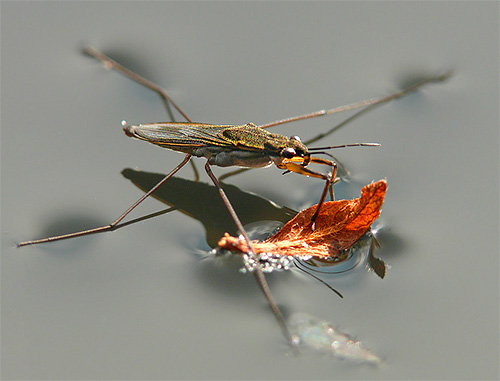
Bed bugs lay their eggs on the leaves and stems of aquatic plants. Sometimes round whitish eggs are located separately, next to each other, but more often they are fastened with a mucous substance in the form of a ribbon of 40-50 pieces.
The larva of this water bug is in many ways similar to an adult individual - an imago, but differs in a more swollen and shorter body. She is called a nymph and eats the same food as an adult insect. In the photo next to each other, water strider larvae are visible:
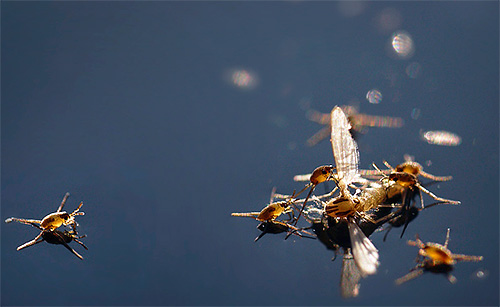


It is interesting
The long legs of the water strider bug are covered with microscopic hairs that trap air and help the bug keep its balance. The abdomen is also covered with whitish hairs and lubricated with a waxy liquid that literally repels water. If you try to "drown" the water strider, nothing will come of it. In the water column, the insect will be surrounded by many air bubbles and appear silvery.
The most famous types of water striders are:
- The water strider is large, one of the largest representatives of this family in our country. The length of her body can reach 17 mm.
- The water strider is a slow, rod-shaped, found in Siberia and has such a thin body that it really looks like a stick.
- The pond strider is remarkable in that it has a variegated color of the paws.
In the tropics, there are the largest species of water striders that can hunt small fish and bite a person quite painfully.
Lifestyle of the water strider bug
For its life, the water strider bug chooses calm stagnant reservoirs or rivers with a very slow current. Thanks to its comfortable long legs, the water strider can easily move not only on the surface of the water, but also on land. This gives the bug the opportunity to live near the water and wait for its prey there.
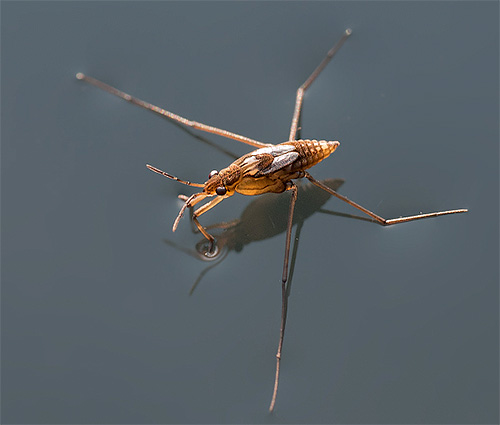
The water strider feeds on small invertebrates, insects (even horseflies) and fish fry. Large spherical eyes (the bug has excellent vision) help to quickly notice the prey and attack it with a sharp proboscis. At the same time, the water strider holds the escaping prey with tenacious front paws.

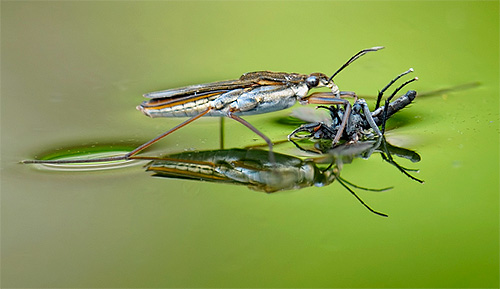
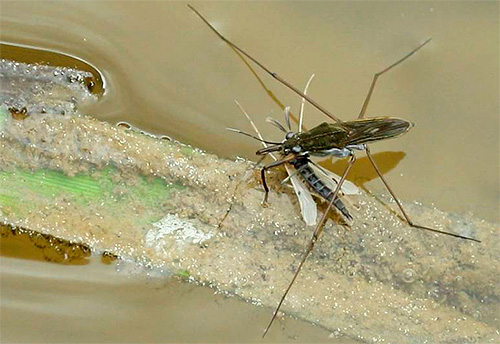
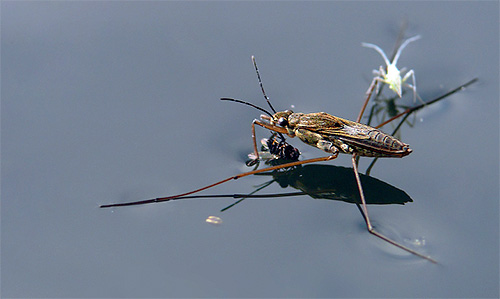
Water striders themselves often become prey for fish, as well as hosts for a small parasite - the larvae of the water mite, which drinks their blood. In a bug affected by such a larva, under a microscope, a red dot can be seen on the chest.
In winter, water striders are not active and hibernate, settling near their reservoir. With the onset of heat, they again begin their former life, actively multiply.
The breeding process is very interesting: the male climbs on the female, but if she does not want to mate, he beats the water with his paws. These sound waves attract predators - enemies of water striders. The female is frightened by such a threat and agrees to contact.
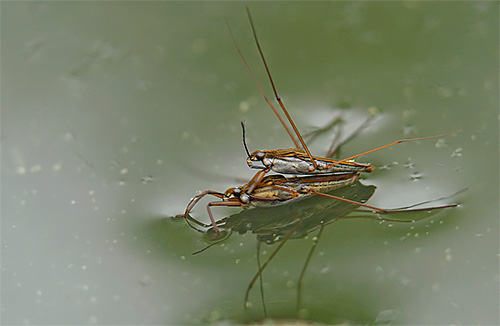
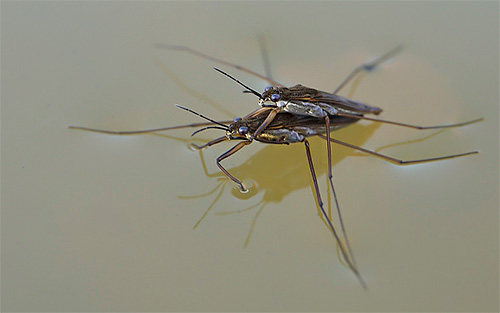
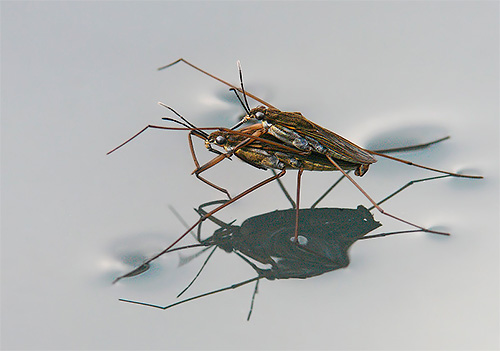
Eggs hatch for about a week, then they are laid either on aquatic plants in the form of a ribbon (in large species), or directly in the cavity of the leaves of plants (in small species). In large water striders, the laying is similar to a ribbon of eggs held together with mucus. In small bugs, such mucus is not produced.
After a couple of weeks, larvae emerge from the egg, which will develop for about a month, going through several stages of molting. The water strider lives for about 1 year.
It is interesting
With the onset of cold weather, winged water striders prepare for wintering on land. During this period, the muscles responsible for lifting the wings atrophy, and the wings themselves fall off, and the adult becomes wingless.
Is the water strider bug harmful?
The water strider bug does not pose any danger to humans. Only in rare cases, when the bug feels threatened or in danger, can it bite. This bite is similar to a weak injection and does not even require special treatment, it does not itch or hurt.
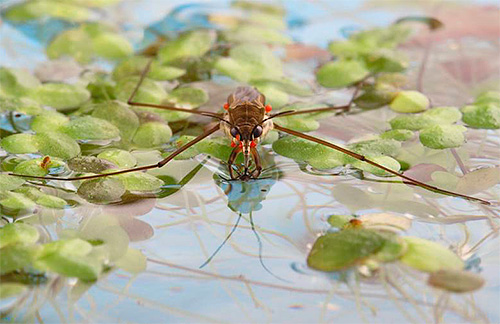
The only damage that water striders can bring is eating fry of valuable fish species. The water strider bug very willingly attacks young fry and kills them by sucking out the contents of the body. Sometimes it can devour clutches of fish caviar.
However, even for complete saturation, the water strider needs very little food, and the fish living in the water column represent for the bug, rather, an addition to the usual diet, which is based on insects and mosquito larvae that have fallen to the surface of the water. This means that for fish farms or the life of individual water bodies, the bug does not pose a tangible threat.
It is interesting
Recently, scientists discovered an interesting and useful feature of water striders: it turns out that these insects play a big role in reducing the number of horseflies. Horsefly females lay their eggs in the water, and their larvae also develop here. Water striders with the same hunting attack both adult flies and larvae. At the same time, an adult horsefly is a fairly large prey for a water strider, and it is usually attacked by several bugs together.Several bugs are able to suck out a horsefly in a few minutes, while one individual usually spends from 40 minutes to 1 hour on this.
The water strider bug is not a parasite and does not cause any trouble to humans. This insect spends almost its entire active life on the surface of the water: there it breeds, feeds and rests.
In the reservoir where these small bugs live, you can swim without fear, and in your free time you can watch the endless running of bugs through the water, resembling a random dance.






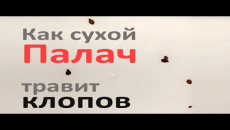
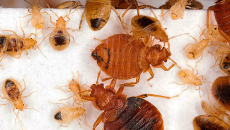
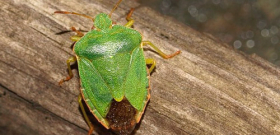


They write that the bite does not itch and does not hurt. So it's not true! I recently cleaned the pond from duckweed and I was bitten by water striders. For a week now, the bite site has been itching, festering and sore.